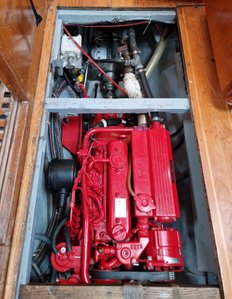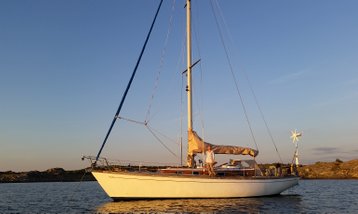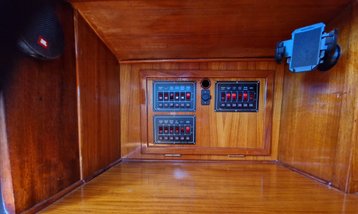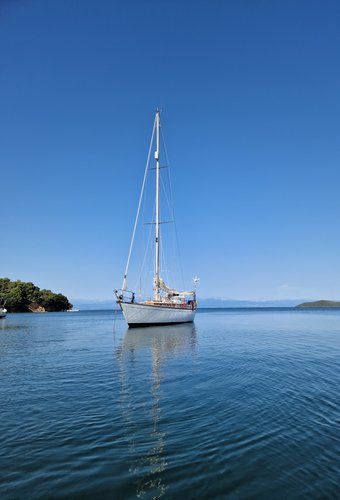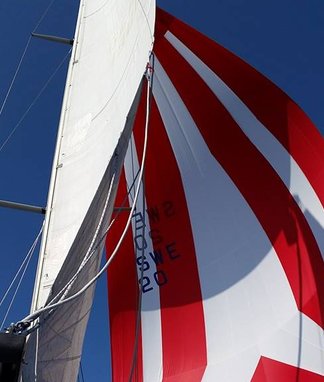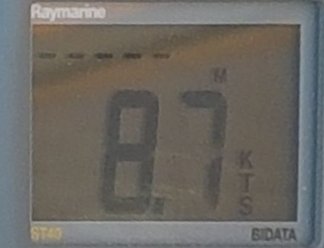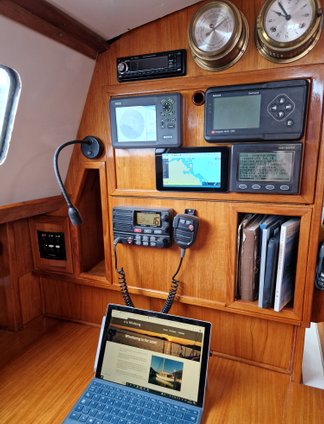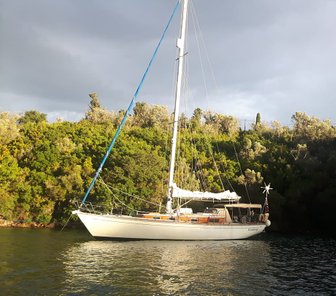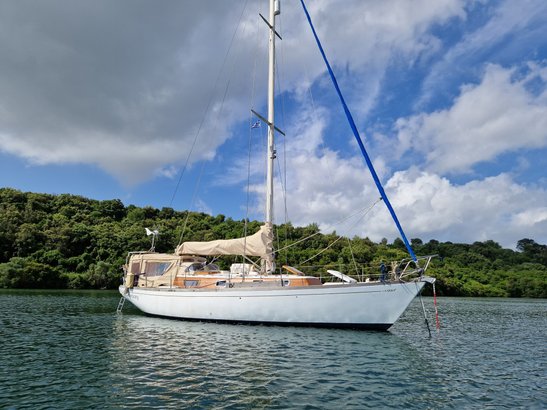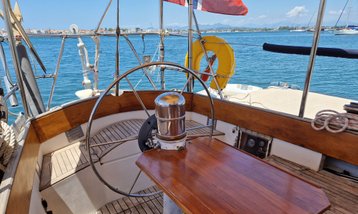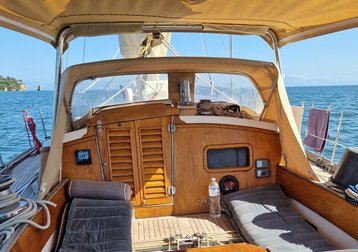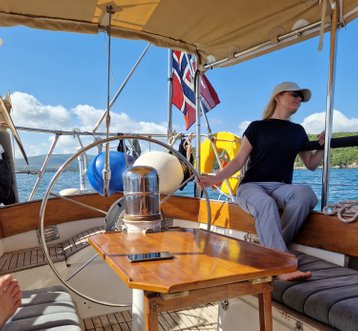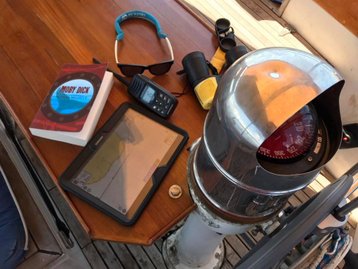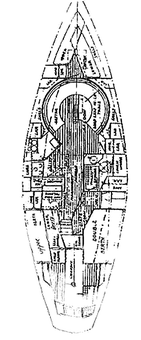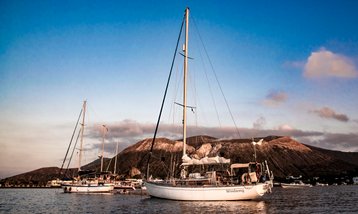Inventory
On this page we provide a complete inventory for the boat. Updated last on May 29th, 2022.
ENGINES/MECHANICAL
Engine
- Make/Model: Beta Marine LTD/Beta 38.
- Age: installed as new in 2014. Engine number 1DL2761
- HP (Each): 37.5
- Engine Hours: 611, as per 24.05.2022.
- Cooling: Fresh water
- Date Engine Last Serviced: Spring 2022
- Drive Type: Shaft, through AquaDrive and feathering propellor (see below for details).
- Fuel Type: Diesel
- Fuel Consumption L/Hr: Have measured anything from 1.6-3.5, depending on load. In normal cruising speed: 2.5 l/h.
- Range: 400 nm (based on 2.5 l/h, 5 kn0os, 200 l tank).
- Cruising Speed under engine: 5 knots
- Maximum Speed under engine: 6.6 knots
Drive train
- Gear box: TMC 60P, installed new with the engine in 2014.
- Propeller: Featherstream propeller from Darglow Engineering in the UK. This has almost no drag while sailing, while still being a very efficient propeller both ahead and in reverse. Installed new with the engine in 2014.
- Aquadrive is installed between the engine and the shaft, which means that it is much easier to align the engine. The Aquadrive is mounted on a very sturdy stainless steel bracket.
- A Vetus drip-less shaft seal was mounted when the engine was new. This is lubricated with water from the raw-water circuit of the engine, which then also lubricate both cutlass bearings. I just discovered that this drip-less seal is not drip-less any more, and should probably be serviced and/or replaced soon.
TANKAGE
- Fuel: 200 l, GRP
- Water: 375 l, GRP lined with special epoxy for potable water tanks.
- Holding tank: Stainless steel. The tank is sizeable, but exact volume unknown. Guess: 120 l. There is an gauge to be mounted externally to this tank. This is new in the box, and has yet to be mounted. The holding tank can be emptied to sea (offshore). It can also be emptied through dedicated pump-out connections where such facilities exist.
ELECTRICAL
Storage
- Domestic batteries: 2, total about 200 AHr's (from memory), AGM. With the current charging setup, domestic power is rarely (never?) an issue.
- Engine Starter: 1 AGM battery, 100 AHr (from memory).
- Windlass Battery: Instead of having a separate heavy battery in front for the windlass, the windlass uses start battery through over-dimensioned marine cables.
Charging etc.
There are many ways to charge the batteries, through solar panels, a wind generator, by engine, or by battery charger.
- Two 100 W solar panels are mounted on arcs above the rear bimini structure, and connected to an advanced regulator to maximize output. All this is from Victron. There is also a small solar panel on the hatch garage, connected to a separate regulator.
- A small wind generator (Ruthland 914i) also gives some power. It does not have a very high output, but starts at low wind speeds and is very quiet compared to larger wind generators.
- The engine alternator can course also charge the house batteries.
- There is a shore power connection in the cockpit (cable is included). This powers a 220 V outlet inside the boat, and also a 220 V charger for the batteries. This is a "Sterling Marine Power", 12V, 25A.
- Under way, 220V power can also be had onboard through an inverter.
RIGGING
- Type of Rig: Bermuda (or Marconi-) rig (i.e. normal sloop rig with triangular sails).
- Note that a new bulkhead has been constructed in the forepeak. This is thoroughly tabbed to the hull and the deck, and could (I believe) serve as a fixing point for a cutter stay, should this be desired (this was the plan).
- Spars Material: Aluminum, tow set of spreaders.
- Standing Rigging: Very sturdy. Some of the rig was installed by a previous owner, at unknown date, but much has been replaced as necessary. Following a survey of the rig in 2016, the back-stay, forestay and the rear lower shrouds were renewed. The chain plates were taken out and checked in 2007, and re-installed (and the deck re-built around their entry point to avoid future leaks). The backstay is adjustable.
- Running Rigging: Varying age, replaced as necessary. Main and genoa halyards are Dynema.
- Mainsail sheeting:
- The sheet can be used in two positions: The original position was on The bridge deck in the cockpit. To be able to sail with the full bimini, I have also made a sheeting position on the cabin top, ahead of the sprayhood, with solidly backed fixing points.
- Regardless of sheeting position, the other end of the sheet is led to the helm, "German sheeting" style.
- Mainsail Reefing: Slab, handled at the mast. Can be reefed while close hauled, or even easier while hove to (the boat heaves to beautifully).
- Lines lead aft to cockpit: Sheets and kicker. Halyards and reefing lines are on the mast.
- Winches: 2 on the mast, 5 in the cockpit.
- Stack-pack / Lazy jacks: Lazy jacks, yes.
- Furling Headsail: Yes
- Spinnaker Pole: Yes
- Mast Steps: A pair at the top, for working on masthead.
SAILS
All sails have been covered when not sailing, and have been taken off and stored dry when we are not using the boat. The boat was not used in 2020 or 2021, due to the pandemic.
Sails:
-
- Main: Tasker Offshore. This was new in 2016, and is in very good condition.
- Genoa: Unknown age. Works, but soon ready for replacement. Furling.
- Storm Sail: New, un-used. Bought in 2015 or 2016.
- Gennaker/Cruising Spinnaker: Bought second hand, but has seen very little use. Very good condition.
Sail covers: Yes, traditional sunbrella cover for the main, and UV-protection strip on the furled genoa.
Cruising speed under sail 5-6 knot. Max around 9 (through the water).
NAVIGATION
- For navigation we use a combination of a pad (running Navionics, the pad is not included), and a simple chart plotter at the chart table. Many new, un-used paper charts for the Med are also available.
- Chart Plotter: This is based on a Raspberry Pi with touch screen, running OpenPlotter. It connects to a GPS dongle.
- GPS: There is an old Phillips unit (navigator MK8), but this is not finding any satelites (maybe the antenna is the problem). There is the GPS dongle for the Raspberry Pie mentioned above for redundancy, and off course if you navigate by Pad, this will have its own GPS. Hower, since both the AIS and DSC VHF needs GPS input, a new GPS unit (or antenna) is probably needed.
- Radar: No
- AIS: Yes, Seatec AIS-6.
- Autopilot: Yes
- VHF Radio: Yes, with DSC. Standard Horizon GX3000E.
- Echo Sounder: Yes, Raymarine ST40. However, we discovered just now that the sensing unit (which is mounted in a cup inside the hull) is no longer working properly and should be replaced.
- Log / Speed: Yes, Raymarine ST40
- Wind Instrument: Yes, Raymarine ST40
- Wind Indicator at Masthead: No (use your ears)
- Navtex: Yes
- Compass: Yes, two.
- Barometer: Yes
- Clock: Yes
ANCHORING
- Anchor Locker: The original anchor locker was too small, and too far forward, and so a new much more roomy locker was constructed. The aft part of the locker consists of a new bulkhead which I also planned to use as the foundation for a cutter stay (this never happened, but is an option if a new owner wants such a modification to the rig).
The anchor locker has a waterproof hatch in the forepeak, and drains through a separate through-hull. The anchor locker re-build sacrificed the end of the upper berth in the forepeak cabin. The upper berth can still be used for a child, but when cruising has been used for dry sail storage. The lower berth is still very much functional. - Anchors: Rocna, 25 kg. Very good anchor! Aft there is a Fortress type "dregg", mostly used for "Scandinavian mooring".
- Anchor Chain / Warp: 50 m of 10 mm chain. Extra warp.
- Anchor Windlass: Yes, Anchorlift. This has a switch at the helm, and also on the foredeck, for raising the anchor. The corresponding switches for lowering the anchor is not working (you don't really need it, but it should off course be fixed).
COCKPIT
- Cockpit Table: Yes
- Cockpit Lockers: Yes, on both sides. Also, a lazarette.
- Spray hood- Yes
- Cockpit Cover/Bimini: Yes.
- To clarify, the bimini is a custom design. A sturdy stainless steel framework at the rear of the cockpit holds the rear section of the bimini. Using only this, the boat can be sailed with the main sheet on the bridge deck. For cruising, we normally extend the bimini to the framework over the sprayhood (see under Safety below), to get shade in the whole cockpit. This requires that we use the cabin top sheeting position (see above under Rigging).
- The bimini has a set of extra panels that can be zipped on, forming a partial or complete enclosures (with windows with "curtains").
- The boat can be used with this enclosure on, both with engine and under sail.
- Cockpit / Deck Shower: No, but can very easily be mounted in the cockpit.
- Pushpit / Pulpit: Yes
- Boarding Ladder: Yes
- Davits: No
Note that the boat can be sold without the windsteering system. Taking this off (4 bolts) will free a lot of space at the small swimming plattform at the stern, and make it a lot easier to climb onboard. We manage just fine as it is, though...
SAFETY
- Life raft: Yes, Viking, 6 person, last serviced in 2019. Whether it follows the boat is negotiable.
- Lifebuoys: 1
- Floating Lights: Yes, tied to lifebuoy.
- Flares & Expiry date: Yes, but out of date.
- Foghorn: The handheld variety.
- Search Light: Yes, handheld.
- Gas Detector: Yes
- Radar Reflector: Yes
- Jackstays: Yes, in the cockpit, and from the cockpit to the bow.
- Intruder Alarm: No
- Fire Extinguishers: Yes, 2.
- Fire Blanket- Yes, 1.
- Bilge Pump(s) Manual- Yes, 1.
- Bilge Pump(s) Electric- Yes, 1.
- Cockpit:
- many clip-on-points. You can clip on before exiting the boat easily move securely along jackstays to the helm.
- Around the sprayhood there is a custom (very sturdy) stainless steel framework which serves as a handhold when stepping onto the deck, and also as a front fixing point for a low (low windage) "Bimini" (see above). A corresponding framework (equally sturdy) has been constructed at the aft of the cockpit, forming both very sequre hand holds in a storm, and also holds the rear part of the "bimini". This framework also carries two powerful solar panels.
INTERIOR / DOMESTIC
The boat has a master cabin, a forepeak cabin, a round saloon in connection with the galley (somewhat improved over the original). A chart table/work station separates the galley from two pilot berths aft on the port side.
There is a combined heads and shower amidships.
All cushions were new in 2018 (the one in the lower pilot berth has a since gotten a paint stain).
Under each cushion, there is a springy mesh distancing material, which prevents condensation. Not such an issue in the Med, but definetely very useful in the Atlantic.
- No. of Berths- doubles/singles:
- Doubles: In the master cabin and also in the saloon if the table is lowered (needs additional cushions).
- Singles: Four: 1 in the forpeak, two aft on the port side, and one that has been constructed by modifications of the circular saloon bench. The latter cannot be used if the saloon is converted to a double.
- Headroom- 180 (side) - 192 (center) cm
- Upholstery: New in 2018, throughout. With anti-condensation base (see above)
- Curtains: Only in the master cabin.
- Flooring: Teak with solid plywood backing.
- Chart Table: Yes, teak, varnished.
- Saloon Table: Yes, teak, varnished.
- Hanging Locker(s): Yes, 2
- Wet Locker(s): The shower/head is used for this.
- Heating: A "danish fishermans" diesel stow (Refleks), which also heats water for central heating. Radiators in forepeak, head, master cabin and at the chart table keep the boat dry and warm even in late Norwegian autumn, significantly extending the season.
- Air Conditioning: No.
- Number of Heads: 1
- Toilet Type- Manual pump, new in 2018 or 2019. Can pump directly to the sea or to the holding tank, according to the situation.
- Shower: Yes, internal. Drainage through floor via separate automatic sump box.
- Microwave: No
- Hob: Yes, new in 2018(approx).
- Oven Yes, new in 2018(approx).
- Grill: No
- Galley Sink: Yes, with proper faucets (not the wimpy ones you get in chandleries).
- Cool box/fridge: Yes, top loaded, about 2 cubic feet, very well insulated.
- Freezer: No, but the cooling element in the fridge keeps frozen stuff cold for some time.
- Water System: Yes, pressurized.
- Hot water: Calorifier. Heated by the central heating, but can easily be modified to be heated by engine cooling water.
- Water Maker: No
- Stereo: Yes
- TV: No
MISCELLANEOUS
- Dinghy- Walker bay 8ft, with sailing rig. Not very pretty, but extremely versatile, robust, and light. Can take an inflatable ring for more carrying capacity. Can also take a small outboard. None of these exists, however, since we have managed fine with the basic simple dinghy, and oars (the sail rig is mostly for playing…).
- Warps - number: Enough
- Fenders - number: 7
- Loads of spare parts for the various systems.
